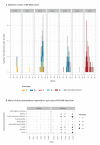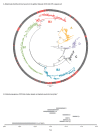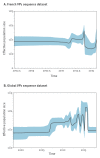Molecular diversity and biennial circulation of enterovirus D68: a systematic screening study in Lyon, France, 2010 to 2016
- PMID: 30229724
- PMCID: PMC6144471
- DOI: 10.2807/1560-7917.ES.2018.23.37.1700711
Molecular diversity and biennial circulation of enterovirus D68: a systematic screening study in Lyon, France, 2010 to 2016
Abstract
BackgroundUnderstanding enterovirus D68 (EV-D68) circulation patterns as well as risk factors for severe respiratory and neurological illness is important for developing preventive strategies. Methods: Between 2010 and 2016, 11,132 respiratory specimens from hospitalised patients in Lyon, France, were screened for EV-D68 by PCR. Phylogenetic relationships of the viral-protein-1 sequences were reconstructed using maximum-likelihood and Bayesian-Markov-Chain-Monte-Carlo approaches. Results: Overall, 171 infections with a biennial pattern were detected, including seven, one, 55, none, 42, one and 65 cases annually during 2010-16. Children (< 16 years-old; n = 150) were mostly affected and 71% (n = 121) of the total patients were under 5 years-old. In 146 patients with medical reviews, 73% (n = 107) presented with acute respiratory distress. Among paediatric patients with medical reviews (n = 133), 55% (n=73) had an asthma/wheezing history, while among adults (n = 13), 11 had underlying diseases. In total, 45 patients had severe infections and 28 patients needed intensive care unit stays. No acute flaccid myelitis (AFM) was detected. We found genotypes A, B1, B2 B3 and D circulating, and no associations between these and clinical presentations. During the study, new genotypes continuously emerged, being replaced over time. We estimated that ancestors of currently circulating genotypes emerged in the late-1990s to 2010. Rises of the EV-D68 effective population size in Lyon coincided with infection upsurges. Phylogenetic analyses showed ongoing diversification of EV-D68 worldwide, coinciding with more infections in recent years and increases of reported AFM paediatric cases. Conclusions: Reinforcement of diagnostic capacities and clinical-based surveillance of EV-D68 infections is needed in Europe to assess the EV-D68 burden.
Keywords: EV-D68; clinic; enteroviruses; laboratory surveillance; respiratory infections; typing.
Conflict of interest statement
Figures





Similar articles
-
Enterovirus D68 detection in respiratory specimens: Association with severe disease.J Med Virol. 2017 Jul;89(7):1201-1207. doi: 10.1002/jmv.24772. Epub 2017 Mar 28. J Med Virol. 2017. PMID: 28165146 Free PMC article.
-
First Enterovirus D68 (EV-D68) cases detected in hospitalised patients in a tertiary care university hospital in Spain, October 2014.Enferm Infecc Microbiol Clin. 2015 Nov;33(9):585-9. doi: 10.1016/j.eimc.2015.01.008. Epub 2015 Feb 28. Enferm Infecc Microbiol Clin. 2015. PMID: 25735714 Free PMC article.
-
Enhanced genomic surveillance of enteroviruses reveals a surge in enterovirus D68 cases, the Johns Hopkins health system, Maryland, 2024.J Clin Microbiol. 2025 Jul 9;63(7):e0046925. doi: 10.1128/jcm.00469-25. Epub 2025 Jun 10. J Clin Microbiol. 2025. PMID: 40492725 Free PMC article.
-
The Emergence of Enterovirus-D68.Microbiol Spectr. 2016 Jun;4(3). doi: 10.1128/microbiolspec.EI10-0018-2016. Microbiol Spectr. 2016. PMID: 27337448 Review.
-
Global reemergence of enterovirus D68 as an important pathogen for acute respiratory infections.Rev Med Virol. 2015 Mar;25(2):102-14. doi: 10.1002/rmv.1820. Epub 2014 Dec 3. Rev Med Virol. 2015. PMID: 25471236 Free PMC article. Review.
Cited by
-
Re-emergence of enterovirus D68 in Europe after easing the COVID-19 lockdown, September 2021.Euro Surveill. 2021 Nov;26(45):2100998. doi: 10.2807/1560-7917.ES.2021.26.45.2100998. Euro Surveill. 2021. PMID: 34763750 Free PMC article.
-
Epidemiological and Clinical Insights into the Enterovirus D68 Upsurge in Europe 2021-2022 and Emergence of Novel B3-Derived Lineages, ENPEN Multicentre Study.J Infect Dis. 2024 Oct 16;230(4):e917-e928. doi: 10.1093/infdis/jiae154. J Infect Dis. 2024. PMID: 38547499 Free PMC article.
-
A self-amplifying RNA vaccine prevents enterovirus D68 infection and disease in preclinical models.Sci Transl Med. 2024 Aug 7;16(759):eadi1625. doi: 10.1126/scitranslmed.adi1625. Epub 2024 Aug 7. Sci Transl Med. 2024. PMID: 39110777 Free PMC article.
-
Understanding Enterovirus D68-Induced Neurologic Disease: A Basic Science Review.Viruses. 2019 Sep 4;11(9):821. doi: 10.3390/v11090821. Viruses. 2019. PMID: 31487952 Free PMC article. Review.
-
Global prevalence and case fatality rate of Enterovirus D68 infections, a systematic review and meta-analysis.PLoS Negl Trop Dis. 2022 Feb 8;16(2):e0010073. doi: 10.1371/journal.pntd.0010073. eCollection 2022 Feb. PLoS Negl Trop Dis. 2022. PMID: 35134062 Free PMC article.
References
-
- Khetsuriani N, Lamonte-Fowlkes A, Oberst S, Pallansch MA, Centers for Disease Control and Prevention Enterovirus surveillance--United States, 1970-2005. MMWR Surveill Summ. 2006;55(8):1-20. - PubMed
MeSH terms
Substances
LinkOut - more resources
Full Text Sources
Other Literature Sources
Research Materials
Miscellaneous
